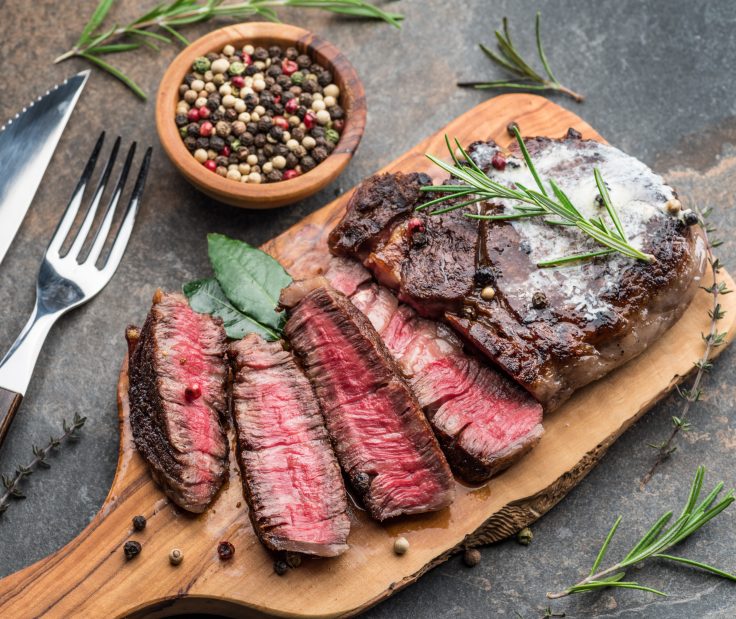Among steak lovers, is there anything more overrated than grass-fed beef? Perhaps you bought it because you wanted to treat yourself. It costs more so it must taste better. Except it doesn't.
In Glorious Beef, author and butcher extraordinaire Pat LaFrieda confirms my suspicions. "The chefs simply didn't like it," he says. "I thought it was a surefire sale given its favorable marketing points, but in the restaurant world, it all comes down to appealing to the chef's palate, and grass-fed beef wasn't cutting it. No one really liked the flavor, and they didn't buy into the sustainability selling points."
The reason for this aversion is obvious. If all cattle do is eat grass every day (as opposed to grain), the beef is guaranteed to be lean and lacking "the delectable intramuscular fat we rave about when acquiring a high-quality cut of meat." What's more, "organic grass-fed beef also tends to be expensive due to the cost of setting up and maintaining organic soil, but that doesn’t necessarily translate into higher quality beef."
Twenty-two years ago, Kitchen Confidential took the publishing world by storm. Readers were riveted by Anthony Bourdain's "Adventures in the Culinary Underbelly." He gave us a peek behind that double-swinging door (avoid "discount" sushi, don't order seafood on a Monday, never let a bride into the backroom). Glorious Beef does something similar.
LaFrieda, who comes from a long line of butchers, reveals the rough and tumble of the industry—USDA inspectors who wielded enormous power and "could close the operation on a whim"; mobsters who controlled New York's Fourteenth Street Market (LaFrieda's grandfather was friendly with Paul Castellano); rivals who slashed delivery truck tires and severed phone lines. There is no mistaking this is a cut-throat business, sometimes literally: The author once had to pull off an employee who pressed a knife against a fellow butcher. "He was immediately let go."
And much like Kitchen Confidential, Glorious Beef is filled with useful tips and insights. Salt but don't pepper your steak before it's cooked—otherwise it can leave a bitter aftertaste. (LaFrieda's favorite cut is the economical skirt steak.) Of all the tools at a butcher's disposal, the bandsaw is "the most revered and panic-inducing machine of them all," slicing through bone like butter.
The key ingredient in LaFrieda's hamburger meat is brisket. "However, its fat content is obscene, so it must be mixed with other cuts, such as chuck, to get the perfect burger." Perfect, of course, is subjective, but it was perfect enough for restaurateur Danny Meyer, who was looking for someone to supply his new burger concept, Shake Shack. LaFrieda remembers visiting the first outpost in New York's Madison Square Park. "We had never seen such a long line of people willing to wait for an hour or more just to get their hands on a burger. It was staggering, and it changed our lives."
Carnivores will benefit from the book's guidance on purchasing meat at the store. There's the obvious—look for beef that's bright red and well marbled. But if you've ever been tempted to purchase that marinated meat on sale behind the glass, "just keep in mind it is likely meat that is on the verge of going bad."
If you can't find a label indicating a grade—Prime, Choice, or Select—it's likely below that. But there are actually eight grade levels. The bottom three are Utility, Cutter, and Canner, "used in pet foods, and canned goods, and … shipped to prison systems and to the armed forces."
LaFrieda doesn't shy away from describing where his meat comes from, though he prefers the euphemism "harvesting facility." It's "not a happy place," he admits. (Ever see a menu that cites the source of its product coming from Creekstone Farms? That's no farm—that's a harvesting facility!) That said, he fully embraces the stunning method, which keeps the cattle calm. It's not only humane, he insists, but also makes for better meat. "If an animal is stressed out, anxious, or terrified, that fight-or-flight reaction will naturally blast adrenaline through its body, tensing it up and resulting in tougher beef."
The message of Glorious Beef is clear: Don't feel bad about eating meat—it's not as bad as they say it is. As LaFrieda explains from the outset, "There are two sides to every story; however, in the beef industry's case, only one seems to get most of the airtime. I want to help correct this mistake and reveal the side that is usually ignored by the media, which often presents a simplistic, one-dimensional story."
And to his credit, LaFrieda strives to be fair and balanced. He supports the meatless burger trend. He even backed Beyond Meat and sells Impossible Burgers. But he's quick to point out if your concern is health, the alternative isn't any better. A standard beef burger has about 70 milligrams of sodium. The plant-based variety? A whopping 370 milligrams. "Then there's the ingredient list. These plant-based patties list around twenty ingredients versus the one ingredient in beef burgers: chopped beef."
The author's current obsession is with dry-aging, a costly process that requires twin cooling and dehumidifying systems—moisture will otherwise spoil the meat. Primals are aged 14 to 120 days and the result, says LaFrieda, "is ten times more tender and has ten times the flavor of its fresh counterpart." This, too, is subjective. But LaFrieda wouldn't have built a storage facility for 12,500 dry-aged primals if there wasn't a demand for it.
Organic, grass-fed, dry-aged, and plant-based varieties of meat only exist because consumers desire them. And LaFrieda is willing to give the customers what they want, even if they happen to be a bit misguided. The only thing certain is after reading Glorious Beef, you'll have a hankering for a big juicy bone-in rib eye. Corn-fed, of course.
Glorious Beef: The LaFrieda Family and the Evolution of the American Meat Industry
by Pat LaFrieda
Ecco, 224 pp., $28.99
